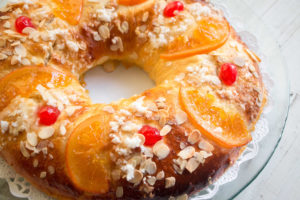My husband Leon and I moved from Mexico to Canada in 2015. It was our plan to work and learn in Canada “for just two years”. We’ve been here now for almost seven years, so I guess you could say our plans have changed. Of course, you know what they say: “If you want to make God laugh, tell him your plans.”

Maria Morales and her husband Leon
If you have ever moved to a different country or city, I think you’ll agree with me that there are many reasons behind this choice, and there are so many experiences involved that there is no way we would have been able to look into the future and grasp what it was going to be like.
We didn’t just turn off our “old self” switch and become these perfectly blended Canadian residents. Elements from our own culture, the people we grew up with, and the behaviours that make us feel at home will probably always be with us.
I asked a group of Mexicans now living in Canada about their experiences. I invite you to grab a cup of coffee or tea and get comfortable, as together we explore some of the details of finding a way to balance this duality of culture.
Food customs are a big topic among Mexicans living abroad; for example, times to eat meals are different from Canada.
In Mexico we usually have a big breakfast around 8 a.m., next a big meal (la comida) close to 3 p.m, and then dinner around 7 p.m. If you go out to party, you will almost surely get tacos at midnight.
In Canada, the custom is a small breakfast, a big lunch close to noon and then dinner around 6 p.m. There are no taco stands.
Noticing this change, I learned that everyone’s “hungry” times are different as well. And it seems that “social eating” times are mostly related to social habits. Things like when you usually have lunch break or coffee break at your job, and the weather, have an influence also. Mexican friends living in other countries like Germany and the U.S. agree with this as well.
I speak for myself here, but the food I miss above all from Mexico is fresh cheese from the rancho (farm). When I first arrived in Canada, I felt sad about it, but I’m glad I didn’t stay in Mexico “just” for the cheese because I have recently become lactose intolerant. I’m joking. But as a side note, fresh cheese is amazing. If you haven’t tried it yet, you must. In Canada there are regulations that don’t allow producers to produce cheese with the texture and flavour of fresh cheese in Mexico. It is one of the things we must learn to live without (cue dramatic music).
Spiciness and food choices are also different in every country. I remember one time I made a meal and shared it with a Peruvian friend. As we ate, I was thinking to myself, “Wow, this meat is truly sweet!” At that exact moment, she said, “Wow, you guys cook meat really spicy.” I found it interesting how, despite our shared Latin American heritage, we perceived and described a meal so differently.
Many of us newcomers to Canada rely on creativity to re-create those experiences that bring us joy and good memories from our childhood. Like my friend Syria, who grew up in El Salvador. She found a baker in Canada to make a “Rosca de Reyes” especially for her family. “Rosca de Reyes” is a traditional bread we enjoy on the Christian Feast Day of the Epiphany of the Lord, when the three Magi brought gifts to the baby Jesus. This is an oval-shaped sweet yeast bread, with orange pieces and other dried fruit as a topping. Inside we hide a little plastic baby (a toy-like figure) to remember the time when Herod gave the order to kill all the baby boys in Bethlehem and its vicinity, in accordance with the information he had learned from the Magi. The tradition is that whoever finds the baby in their piece of bread is blessed. He or she has had the opportunity to save a life, and therefore will be lucky in the year ahead. That person must also make the tamales for Candelaria day, which is the last day of the Christmas season. Naturally many people prefer not to find the baby.

Rosca de Reyes. Photo by Asife
But eating the Rosca is a family affair that is a lot of fun, as everyone watches closely to see who gets the baby. In Canada hiding a toy inside bread is considered a hazard, so it’s illegal to sell bread with plastic toys inside.
Piñatas are also a well-known Mexican tradition. Every good birthday party in Mexico has a piñata, and breaking a piñata is a special experience. I love this story from my Mexican friend Clara, who now lives in Canada. She had a piñata at her son’s birthday party, and as it turned out, many of the kids at the party were of Asian descent. They took turns hitting the piñata, but they were very polite in the way they were doing so. Finally, it was the turn of the birthday boy, who began hitting the piñata like we usually do in Mexico – with, shall we say, “lots of energy”. Clara recalled that many of the party-goers started saying “Oh…! Oh….! Oh…!” and appeared to be rather alarmed.
Another huge change is, of course, language. It may seem obvious, but some things are totally untranslatable from one language to another. For example, the popular Mexican slang “tengo hueva”, literally translates to “I have roe” (fish eggs) but means “I feel tired”. And just to make it more complicated, you would never say “tengo hueva” in a work setting. It is seen as unprofessional. You should instead say “Me siento cansado” which also means “I feel tired”.
Festivities are different as well; for instance, Halloween is a popular celebration in English-speaking countries, but in much of Latin America it is misunderstood. In Mexico, we celebrate Day of the Dead around the same time of year, which it is seen by Mexicans as more “culturally appropriate” because it is a tradition in which we honour our ancestors. Halloween is more often seen as a “cultural invasion of endless amounts of sugar”, and many of my Mexican friends fear the Jack-O-Lanterns. Once a Canadian friend asked me, “How can you be afraid of a pumpkin? It is literally just fruit. Whereas in your Day of the Dead there are skeletons. I don’t get how Halloween is scarier than Day of the Dead”. It took me a while to assimilate this new-to-me festivity, but now I celebrate both.
Being open to new customs from a place of respect, while knowing your own core values deep down, and the reasons behind your own customs, can lead you to amazing experiences. I think more times than not you will realize that there are far more things that bring us together as humans.

Maria, Leon and their two children
If you want to learn more about specific customs from other countries and don’t know where to look for events, reach out to that country’s local embassy or consulate. They usually make plans for their country’s cultural events, and a staff person will be able to share details about certain traditions with you.
Probably after reading this, you are thinking about your own culture and customs. I would like to leave you with a thought. A fitness trainer once said to me: “Go somewhere between not enough and too much.” I think that’s a great tip.
We are all so different that there is no impeccable blending measure or perfect mix. There is not a scale for how well you are balancing your birthplace culture with the culture of the country you now live in.
You determine your own “somewhere between”.
You can find more of Maria Morales’ work here:
http://mariafreakingcolores.wordpress.com (Poetry and painting; Spanish)
Follow Maria on Instagram at @coloresfitness







